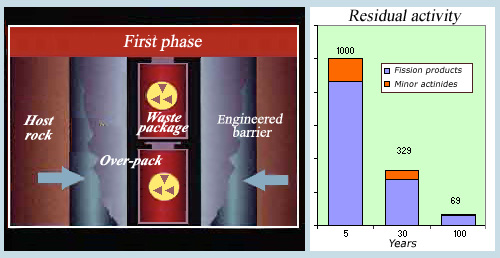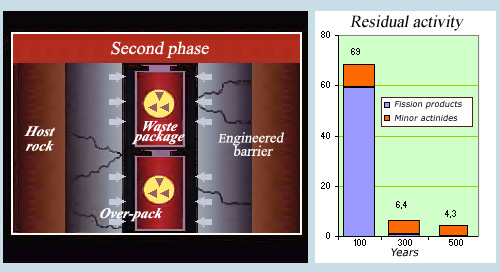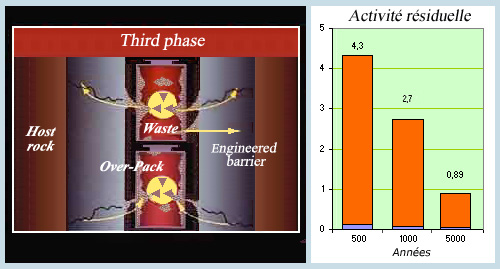Trapping radioactivity until it disappears

The first century…
This is the first leg of the race between the natural decay of radioactivity and the degradation of the barriers used to contain it. Packages of highly radioactive waste have been stored in concrete structures at a very great depth, in a very stable host rock selected in France. No water flows through it, or if it does, only very slowly. Everything is new. The activity of the package, which is 1000 at 5 years of age, will drop to 69 after 100 years. During the first century, the radioactivity will remain extremely high, but the barriers – still intact – will contain it.
© IN2P3/CEA
A scenario for the long-term future of the waste
It will take many years for the radioactivity of waste destined for burial at great depths to become harmless. But will the barriers erected by humans to prevent the residual radioactivity from reaching the environment last for this long? Between the radioactive decay and the degradation of these barriers, which will win?
The focus of laboratory research into disposal, such as that carried out in Bure, France, on the boundary between the Meuse and Haute-Marne départements, is to understand the long-term impact of waste buried at great depths. At the outset, the obstacles put in place to protect the environment are the glass or ceramic package incorporating the radioactive atoms, the containers and the structure holding these packages, and finally the host rock containing this structure.
These barriers are designed to last much longer than us, but however strong they are, they will deteriorate. There will therefore be a race to see which is slowest: this deterioration or the reduction in radioactivity over time.
In the first 200 years, the activity of the fission products, which will initially be dominant, will diminish by a factor of 500. During this phase – long by human standards – when the activity is at its peak, all three barriers need to be properly sealed. Much later, when the activity has decayed more – at the end of 5000 years – the impermeability of the host rock will be relied upon to contain the last few radioactive atoms.

On a scale of centuries …
The second leg of the race is on a scale of several centuries. The concrete structures will crack and degrade, but the radioactivity will still be contained in the packages. The actinides will have become the dominant elements. In 500 years the activity of our sample package, which was 1000 after 5 years, is now only 4.3 (NB: the timescales given for the degradation of the structures are only an example).
© IN2P3/CEA
One scenario for vitrified highly radioactive waste stored in an underground site consisting of argillaceous barriers could be as follows: in the beginning, in the first few hundred years, the high activity packages will heat the surrounding rock until it reaches a temperature of around a hundred degrees. Barriers designed for these conditions will withstand this.
The rock will then slowly cool at the rate of the radioactive decay of the waste. The metal containers will corrode and the underground structures will settle, potentially opening up cracks in the nearby rock.

On a scale of millennia
The third phase should take place between 500 and 5000 years. The containers and packages will degrade in turn. Some of the mobile radioactive elements will escape from what remains of the engineered barrier. The host rock will be left to prevent the dispersal of the radioactive material. If no water is present, the residual radioactivity (2.7 thousandths after 1000 years) will migrate through it very slowly. A few dispersed mobile radioelements could reach the surface.
© IN2P3/CEA
Much later on (at least ten thousand years later), the radioactive atoms still contained in the glass or the uranium oxide will start to dissolve in any water present, but by this time the radioactivity will have vastly decreased. This dissolution in groundwater will cause the remaining radioelements to disperse, leading to their slow migration into the subsoil. The groundwater will percolate through the pores and cracks in the host rock before reaching a groundwater reservoir and finally ending up at a river.
Experts estimate that after ten thousand years spent in underground rock impregnated with water, one thousandth of the total mass of the glass will have dissolved. The residue of radioactive material released will have to work its way up to the surface. This will be difficult to achieve through geological formations chosen for their impermeability to water.
This plethora of precautions might seem excessive, but very safe containment of radioactive material is necessary if nuclear energy is to be developed.
Other articles on the subject « Waste strategies »
Oklo : a natural reactor
Nature at work over the last two billion years It was noticed by chance in the 1970s that a urani[...]
Diluting radioactivity
A practice for elements with low levels of toxicity Management of radioactive waste generally foc[...]
Putting it out of reach
Containment and burial when it is not enough to wait Letting time do its work is not sufficient o[...]
Conditioning
Packages for trapping radioactivity… Conditioning means containing the radioactivity and im[...]
Temporary storages …
Storing: a useful but temporary solution Storing means tidying an object away with the intention [...]
Deep geological disposal
Ground-level and deep disposal: a definitive solution Deep disposal of the most radioactive waste[...]
Separating and sorting
Sorting radioactive waste has advantages As with household waste, sorting can prove really useful[...]
Destroy (transmutation)
Transforming radioactive nuclei to make them less troublesome… The incineration of househol[...]
What to transmute?
Transmuting long-lived actinides and fission products Long-lived elements: actinides and fission [...]
Transmuting actinides
Attractive in principle, difficult in practice Destroying actinides using fission reactions is at[...]